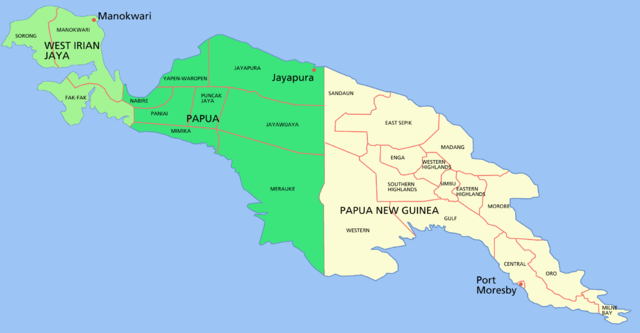island in the Pacific Ocean From Wikipedia, the free encyclopedia
New Guinea is a big island north of Australia. It is the second largest island in the world. Geologically and biologically it is related to Australia. It was first surveyed by Alfred Russel Wallace in the 19th century, who noted that it was, like Australia, on the eastern side of the Wallace line. That means it is closer to Australia than to Indonesia in its flora and fauna.



On the east side of New Guinea is the country Papua New Guinea. On the west side of the island are the Indonesian provinces of Papua, Central Papua, Highland Papua, South Papua, Southwest Papua, and West Papua. These provinces together are called Western New Guinea. The Indonesian "capture" of western Papua New Guinea was a modern act by dictator Suharto of Indonesia.[1] The Australian "capture" of the eastern half was meant to make sure the peoples of this part of Indonesia were left alone.
An early BBC David Attenborough program showed that the country was wooded with many groups of humans speaking many languages. The most notable animals still alive were the birds of paradise. Of marsupials, the quolls are notable. They are small, solitary carnivores. There are six species surviving, two in New Guinea and four in Australia. Echidnas are mammals also known as spiny anteaters.
The number of people on New Guinea is unknown. Indonesia and Papua New Guinea estimated the number around 2020. They say there are about 15 million people. However, the real number could be 23 million or more.[2][3]
New Guinea is important for its nature and biology. Its largest marsupial, the Diprotodon, is now extinct. Native humans live in sparsely wooded, hilly ground in small groups which speak different languages. New Guinea has over 1000 languages. This is more languages than anywhere else in the world.[4]
Still surviving are the birds pf paradise, with marsupials, including wallabies and possums, and the egg-laying monotreme, the echidna. Other than bats and some two dozen indigenous rodents, there are no pre-human indigenous placental mammals. Pigs, several additional species of rats, and the ancestor of the New Guinea singing dog were introduced with human colonization.

Seamless Wikipedia browsing. On steroids.
Every time you click a link to Wikipedia, Wiktionary or Wikiquote in your browser's search results, it will show the modern Wikiwand interface.
Wikiwand extension is a five stars, simple, with minimum permission required to keep your browsing private, safe and transparent.